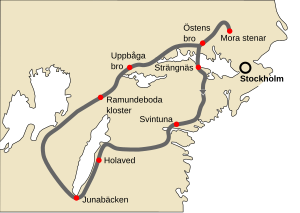122:
51:, hence the need for having the election confirmed by the other regions. The Eriksgata gradually lost its influence when representatives from almost all parts of Sweden participated in the election at the stone of Mora from the 14th century. After 1544, the Swedish King was no longer elected, and instead inherited his throne. This meant that the Eriksgata thereafter had only symbolic importance. The last King to travel the Eriksgata according to the old law was
116:
17:
77:
The
Eriksgata journey was not without risks since there is at least one example of a King being killed during his Eriksgata. This is the incident from the 1120s recorded by Saxo Grammaticus and also in an appendix to the
94:
Ragnvald's decision was taken as an insult to the people of Västergötland, since it showed that he did not fear them, and they killed him in
Karlepitt (an unknown location in Västergötland).
59:
have made visits to
Swedish provinces and called them an "Eriksgata", but those visits have no resemblance to the old medieval tradition.
166:
190:
86:
carelessly decided not to take along the customary hostages from prominent local families while travelling through
200:
159:
195:
185:
152:
103:
90:, even though a rival candidate for the throne had gained support in the province. According to
83:
52:
8:
35:
through the important provinces of the realm to have his election confirmed by the local
91:
87:
79:
132:
140:
63:
36:
56:
136:
179:
71:
67:
40:
32:
28:
47:
and participation was originally restricted to the people in
Uppland or
121:
48:
115:
44:
27:(i.e. "Erik's Road") was the tour traditionally taken in the
16:
62:
The earliest reference of an
Eriksgata is probably from
74:. But the tradition is probably much older than that.
82:. According to these sources, the newly elected King
177:
104:Kulturarv Östergötland "Heritage Östergötland"
160:
66:who c. 1200 wrote about the struggle for the
167:
153:
39:. The actual election took place at the
15:
178:
109:
13:
14:
212:
97:
120:
114:
1:
139:. You can help Knowledge by
7:
10:
217:
191:Medieval history of Sweden
108:
135:-related article is a
21:
20:Route of the Eriksgata
201:Swedish history stubs
19:
70:in the 1120s in his
55:(1604-1611). Later
31:by a newly-elected
196:Monarchy of Sweden
84:Ragnvald Knaphövde
22:
186:Elective monarchy
148:
147:
208:
169:
162:
155:
126:
125:
124:
118:
110:
64:Saxo Grammaticus
216:
215:
211:
210:
209:
207:
206:
205:
176:
175:
174:
173:
133:Swedish history
119:
113:
100:
57:Kings of Sweden
12:
11:
5:
214:
204:
203:
198:
193:
188:
172:
171:
164:
157:
149:
146:
145:
128:
107:
106:
99:
98:External links
96:
9:
6:
4:
3:
2:
213:
202:
199:
197:
194:
192:
189:
187:
184:
183:
181:
170:
165:
163:
158:
156:
151:
150:
144:
142:
138:
134:
129:
123:
117:
112:
111:
105:
102:
101:
95:
93:
92:Västgötalagen
89:
88:Västergötland
85:
81:
75:
73:
72:Gesta Danorum
69:
68:Swedish crown
65:
60:
58:
54:
50:
46:
42:
41:Stone of Mora
38:
34:
30:
26:
18:
141:expanding it
130:
127:
80:Västgöta law
76:
61:
33:Swedish king
24:
23:
29:Middle Ages
180:Categories
53:Charles IX
37:assemblies
25:Eriksgata
49:Svealand
45:Uppland
131:This
137:stub
43:in
182::
168:e
161:t
154:v
143:.
Text is available under the Creative Commons Attribution-ShareAlike License. Additional terms may apply.
